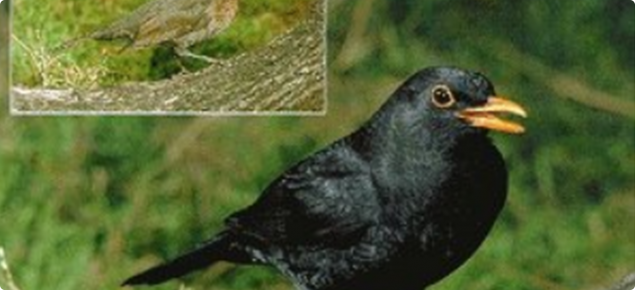Introduction
The introduced common blackbird (Turdus merula) is a pest in eastern Australia. It damages commercial fruit crops and may compete with native birds. The species is prohibited in Western Australia and individuals found here are destroyed.
The Western Australian Organism List (WAOL) contains information on the area(s) in which this pest is declared and the control and keeping categories to which it has been assigned in Western Australia (WA). Use the links on this page to reach blackbird in WAOL.
Identification
The adult blackbird is about 250mm long (including a 95mm long tail) and weighs 100g.
The male is all black with a bright orange-yellow bill and eye ring, and brown-black legs. The female has dark brown upper parts and mottled, paler underparts which are red-brown in colour. The female also has a whitish chin and a yellow-brown bill and legs.
Juvenile blackbirds are lighter brown in colour than females, with more rufous mottled upper parts. Sub-adult males are brownish black with a black bill.
Distribution
The blackbird occurs naturally in Eurasia and North Africa. It was introduced to Victoria before 1862, and spread throughout Victoria, Tasmania, southern New South Wales and eastern South Australia, but its range has only increased marginally over the last 20 years.
Behaviour
The male blackbird's distinctive song during the breeding season is loud and melodious with a flute-like quality. Males often sing from high perches. Both sexes produce a variety of other calls and can also mimic native birds.
The birds spend much of their time on the ground, walking or swiftly bounding with occasional flickering of the wings. Frequent pauses are made with the head tilted to one side as if listening.
Blackbirds often forage in the open, but as they are timid, cover is usually close by. When they forage in leaf litter under trees and bushes, they can sound like a person walking through the bush.
The blackbird's short flights are low and undulating, but fast and direct over open country. The tail is raised and fanned and the wings are drooped on landing.
Normally blackbirds are seen in ones or twos and both sexes are strongly territorial. They are also found in small groups when the young have just left the nest and are still being fed by the parents. The birds do not congregate in large flocks, but occasionally assemble in areas where fruit is ripening.
Habitat and food
The blackbird is found in gardens, orchards, thickets, the understoreys of wetter woodlands and forests and along timbered watercourses. Foods include insects, earthworms, molluscs, spiders and fruits.
Reproduction
The breeding season in eastern Australia occurs between September and January. The nest is a large shallow cup of dried plant material bound together with mud and is normally located one to two metres from the ground in dense vegetation. It may also be on the ground, high in a tree or in a building. The three to five eggs are blue-grey with red-brown spots. Incubation takes 13 days and the young leave the nest after another 13 days. Both adults attend the young. In extremely favourable conditions three broods can be raised in one season.
Damage
Blackbirds are considered pests because they damage a variety of soft fruits including berries, cherries, stone fruit and grapes. They are thought to spread weeds, such as blackberry. They cause damage in gardens and may compete with native birds for food and nesting sites.
Further information
For further information on the blackbird, contact the Pest and Disease Information Service.

